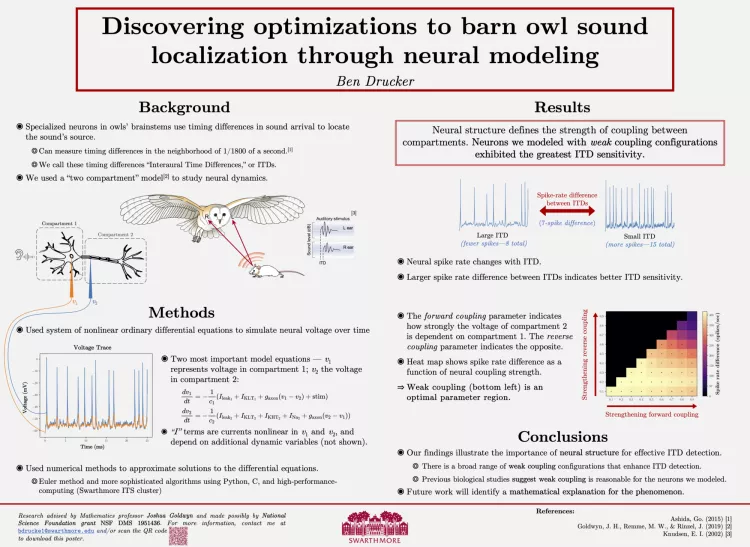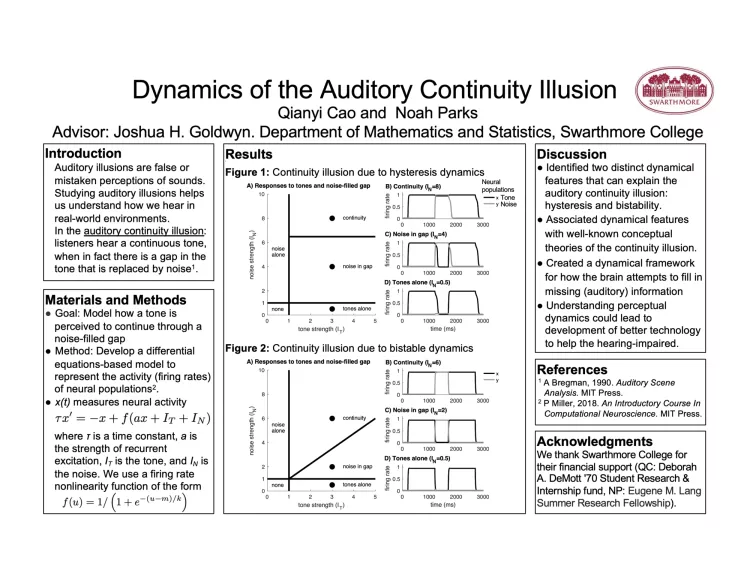Summer research
Students are encouraged to contact me to discuss opportunities for summer research.
Students should read through the information on the college's webpage here to understand the application process and be aware of important deadlines.
Expectation
Typical work days consist of running simulations (most commonly with Matlab or Python), analyzing mathematical models, organizing and visualize simulation data, and reading relevant scientific literature (textbook chapters and journal articles). Students will develop computational skills, learn relevant mathematical techniques, learn about neuroscience and hearing science, and interact with peers and research groups at Swarthmore and elsewhere. While there are no specific pre-requisites for summer research in my group, students will be more prepared for this type of research if they have some knowledge of differential equations (Math 43/44 or similar) and familiarity with scientific computing software (Matlab or python). Course work in biology or neuroscience, or other knowledge of these areas can be relevant, but is not required. That said, students should be interested in gaining some understanding of these areas. Indeed, it is common for students in my research group to read textbooks and scientific literature in neuroscience, hearing science, and related fields.
During the summer we will have regular meetings to discuss progress, answer questions, and plan next steps. Much of the work students do is original research. We won't "know the answer" ahead of time. Grappling with uncertainty and pursuing incremental increases in understanding is central to the research process. Students will be expected to work independently and/or collaboratively (with peers). At the end of the summer, students will write a summary of their findings, organize any simulation code they have developed, and present their research on campus (Math/Stat department summer research talks, Sigma Xi poster session). Depending on the stage and nature of the research, it may be possible for summer projects may lead to conference participation or manuscripts submitted to scientific journals, but there is no guarantee that this can happen for all projects.
COMMITMENT
Students are expected to commit 10 weeks of their summer and to work 40 hours per week (standard for all Swarthmore summer research experiences). For his part, Prof. Goldwyn commits to:
- Advise and guide students' research process based on his expertise in mathematical neuroscience and experience pursuing research in this field. This includes regular in-person (or zoom-based, as circumstances allow); one to three meetings per week is typical, and depends on the stage of the project.
- Provide necessary research resources and equipment the student requires for a successful and productive summer.
- Create a safe and respectful research environment in which all students can thrive and feel valued.
- Mentor students on ways in which their summer research can contribute to success in their future endeavors (academic, professional, or other). This can include: provide detailed feedback on students' writing and oral presentations to aid in developing scientific communication skills; identify opportunities for students to attend or present work at scientific communities (as desired and appropriate for the stage of the research project), and write letters of recommendation that comment accurately on the students' summer research activities for graduate school, jobs, or similar (when requested in a timely manner).
Past projects:
Summer 2022: Modeling ANF and MSO neural responses to cochlear implant stimulation
Anna Jing '23 and Sylvia Xi '24
Cochlear implants are surgically-implanted devices that can provide some sense of auditory sensation, in some cases, for individuals with hearing loss. Users of these devices can have difficulty determining the location of sound sources in their environment ("sound source localization"). To investigate the neural representation of sound source location in the early auditory pathway, Anna and Sylvia developed a computational model to simulate how auditory nerve fibers and medial superior olive neurons respond to cochlear implant stimulation. Anna and Sylvia presented their work at the Swarthmore Sigma Xi poster session and the Sigma Xi IFORE conference

Summer 2021: High-frequency coincidence detection in the barn owl nucleus laminaris
Ben Drucker '22
Barn owls are high-frequency hearing specialists. Remarkably, neurons in a region called the nucleus laminaris are sensitive to submillisecond time-differences in sounds with kilohertz-scale frequencies. Ben developed differential-equations-based models for these neurons and explored how their structure (soma-axon coupling configuration) specializes these neurons for temporal precision. Ben found that weak backward coupling enables these neurons to respond to the high-frequency fluctuations in their inputs that carry information about sound source location. Ben presented his work at the Swarthmore Sigma Xi poster session (see below). You can read more about Ben's experience in this article in the Swarthmore Bulletin.

Summer 2020: Dynamics of the auditory continuity illusion
Qianyi (Angelina) Cao '22 and Noah Parks '22
Perception and neural dynamics can often be probed through the study of illusions. Qianyi and Noah used differential equations methods to develop an original model of neural dynamics for the auditory continuity illusion. They presented their work as the annual meeting of student research conference organized by Sigma Xi (held remotely, due to COVID).
Their presentation can be viewed here

Summer 2019: A minimal model of MSO axon dynamics
Madison Shoraka '20 and JJ Balisanyuka-Smith '21

Summer 2019 student researchers: Madison Shoraka '20 and JJ Balisanyuka-Smith '21
Neurons in an auditory brain stem region called the medial superior olive (MSO) help us to determine the locations of sound sources in the environment. They do this by responding, with submillisecond temporal precision, to the timing of their inputs. Specifically, the MSO neurons receive inputs that origniate from both ears, and fire maximally when the inputs arrive at nearly the same time. For this reason, MSO neurons are known as coincidence detector neurons. Understanding the unique features of MSO neurons that specialize these cells for temporally-precise coincidence detection advances our knowledge of how the auditory systems creates a sense of space and, more generally, how neurons extract timing information from their inputs.
Mads and JJ constructed a model of an MSO neuron to analyze the spiking dynamics of these neurons. They showed that a biophysically-detailed and computationally intensive model (previously published in the literature) could be approximated by using what we call a two-compartment model. The two-compartment model describes two regions of the cell: the soma and dendrite regions are grouped into one compartment, and the axon regions are grouped into the second compartment. Mads and JJ determined how to parameterize this two-compartment model in a principled way to accurately approximate dynamics and spiking of the detailed model.
Their original research provides a new model we can use use to investigate MSO dynamics (simpler to analyze and simulate than the detailed model). The parameterization procedure they developed can also be used by other computational neuroscientists to accurately approximate detailed models of axons with the more parsimonious two-compartment framework.



